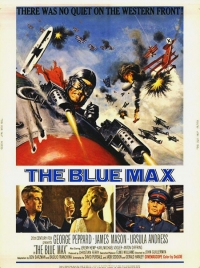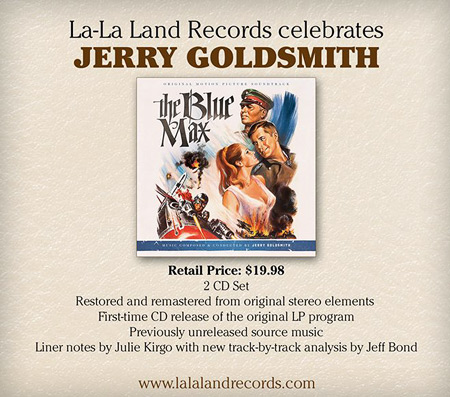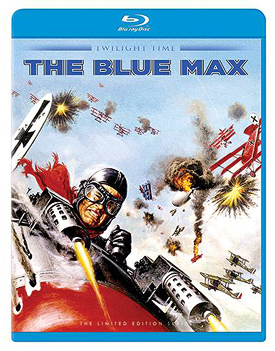PART 1: THE ROADSHOW ENGAGEMENTS
The roadshow engagements of The Blue Max were big-city exclusives that preceded general-release exhibition of the film. Out of hundreds of films released during 1966, The Blue Max was among only twelve given deluxe roadshow treatment. Much like a stage show, these featured reserved seating, an advanced admission price, and were screened an average of only ten times per week. Souvenir program booklets were sold, as well.
What follows is a (work in progress) list of the domestic theatrical “hard ticket” roadshow engagements of The Blue Max, arranged chronologically by date of premiere. The duration of the engagements has been included for some entries. These roadshow presentations were presented in 35mm ’scope with four-track stereophonic sound (though some sources claim 70mm blow-up prints were made and used for some bookings) and included an intermission and entr’acte.
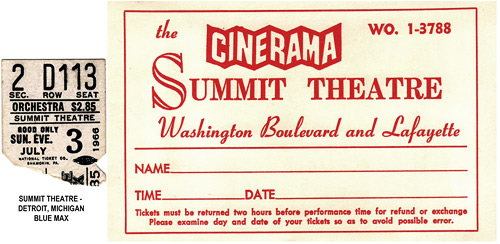
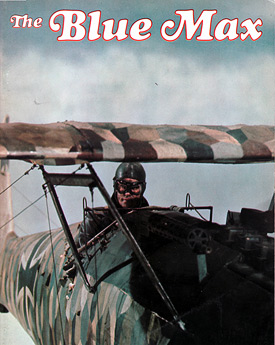
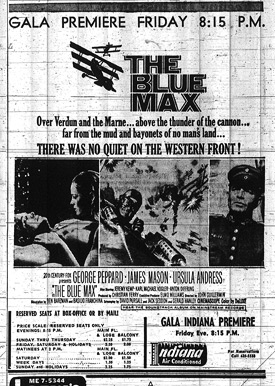
- 1966-06-21 ... New York, NY – Sutton [18 weeks]
- 1966-06-28 ... Dallas, TX – Wilshire [16 weeks]
- 1966-06-28 ... Los Angeles (Beverly Hills), CA – Beverly [14 weeks]
- 1966-06-28 ... Phoenix, AZ – Cine Capri [17 weeks]
- 1966-06-29 ... Boston, MA – Cheri [14 weeks]
- 1966-06-29 ... Buffalo, NY – Kensington [11 weeks]
- 1966-06-29 ... Chicago, IL – Cinestage [14 weeks]
- 1966-06-29 ... Cincinnati, OH – Capitol [11 weeks]
- 1966-06-29 ... Detroit, MI – Summit
- 1966-06-29 ... Jacksonville, FL – Cedar Hills
- 1966-06-29 ... Louisville, KY – Rialto
- 1966-06-29 ... Miami (Miami Beach), FL – Lincoln [16 weeks]
- 1966-06-29 ... Minneapolis (St. Louis Park), MN – Park [17 weeks]
- 1966-06-29 ... Salt Lake City, UT – Studio [31 weeks]
- 1966-06-29 ... San Antonio, TX – Laurel [14 weeks]
- 1966-06-29 ... San Diego, CA – Capri [17 weeks]
- 1966-06-29 ... Washington, DC – Playhouse
- 1966-06-30 ... Halifax, NS – Hyland
- 1966-06-30 ... Montreal, QC – York [19 weeks]
- 1966-06-30 ... Ottawa, ON – Elmdale [13 weeks]
- 1966-06-30 ... San Francisco, CA – Parkside [23 weeks]
- 1966-06-30 ... Vancouver, BC – Park [16 weeks]
- 1966-07-06 ... Pittsburgh, PA – Kings Court [15 weeks]
- 1966-07-14 ... Fort Worth, TX – Ridglea
- 1966-07-20 ... Seattle, WA – Paramount [16 weeks]
- 1966-07-20 ... Virginia Beach (Norfolk), VA – Newport [10 weeks]
- 1966-07-21 ... Toronto, ON – Fairlawn [16 weeks]
- 1966-07-22 ... Fresno, CA – Country Squire
- 1966-07-27 ... Atlantic City, NJ – Center
- 1966-07-27 ... Cleveland, OH – Palace [6 weeks]
- 1966-07-27 ... Denver, CO – Esquire [17 weeks]
- 1966-07-27 ... Kansas City, MO – Brookside [9 weeks]
- 1966-07-27 ... Philadelphia, PA – Goldman [15 weeks]
- 1966-07-28 ... Charlotte, NC – Manor
- 1966-08-03 ... New Haven, CT – Crown [8 weeks]
- 1966-08-10 ... Hartford (East Hartford), CT – Cinema 1 [10 weeks]
- 1966-08-12 ... Baltimore, MD – Hippodrome [10 weeks]
- 1966-08-19 ... Indianapolis, IN – Indiana [12 weeks]
- 1966-08-24 ... Atlanta, GA – Rhodes [17 weeks]
- 1966-08-24 ... Omaha, NE – Indian Hills [17 weeks]
- 1966-08-25 ... Houston, TX – Gaylynn [12 weeks]
- 1966-09-15 ... Des Moines, IA – Ingersoll [8 weeks]
- 1966-09-21 ... Albuquerque, NM – Fox Winrock [7 weeks]
- 1966-09-21 ... Columbus, OH – Grand [17 weeks]
- 1966-09-21 ... Portland, OR – Hollywood [13 weeks]
- 1966-09-21 ... Toledo, OH – Showcase 1 [9 weeks]
- 1966-09-21 ... Wichita, KS – Uptown [18 weeks]
- 1966-09-28 ... Newark (Fair Lawn), NJ – Hyway
- 1966-09-28 ... Oyster Bay, NY – Pine Hollow
- 1966-09-28 ... Richmond, VA – Westhampton [7 weeks]
- 1966-10-05 ... Las Vegas, NV – Fox [11 weeks]
- 1966-10-19 ... Tulsa, OK – Continental
- 1966-10-26 ... Reno, NV – Century 21 [5 weeks]
- 1966-11-09 ... Sacramento, CA – Crest [17 weeks]
- 1966-11-10 ... Syracuse (DeWitt), NY – Shoppingtown [6 weeks]
- 1966-11-23 ... St. Petersburg, FL – Center [12 weeks]
- 1966-12-08 ... Winnipeg, MB – Kings [9 weeks]
- 1966-12-23 ... Oklahoma City, OK – Tower
- 1966-12-29 ... New Orleans, LA – Saenger-Orleans [8 weeks]
- 1967-01-19 ... Lubbock, TX – Winchester [6 weeks]
The first roadshow engagement of The Blue Max held outside North America was in London (at the Odeon Leicester Square) and commenced July 6, 1966, following one week of general-release exhibition. The first foreign-language roadshow engagement was in Paris and commenced August 26, 1966. The first of thousands of domestic general-release engagements were held during the autumn of 1966.
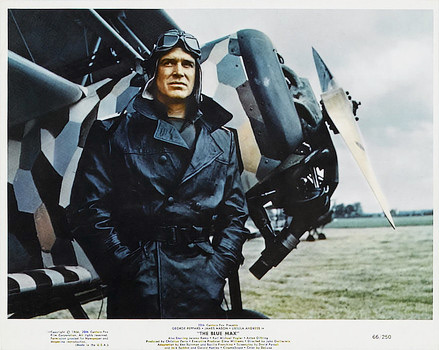
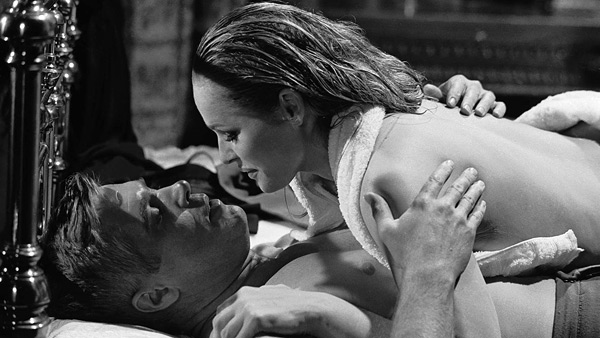
PART 2: THE INTERVIEW
Jeff Bond is a writer and editor and has contributed liner notes to numerous CD soundtrack releases. Jeff currently is the executive editor of Geek Magazine. For several years he covered film music for The Hollywood Reporter. His books include The Music of Star Trek (Lone Eagle, 1999) and Danse Macabre: 25 Years of Danny Elfman and Tim Burton (included in The Danny Elfman & Tim Burton 25th Anniversary Music Box, Warner Bros., 2011).
Jeff spoke to The Bits recently about The Blue Max, including Jerry Goldsmith’s musical score, its new Blu-ray Disc and CD soundtrack releases, and why Goldsmith is one of the most admired and celebrated film composers of all time.
Michael Coate (The Digital Bits): How did you get involved with this soundtrack project?
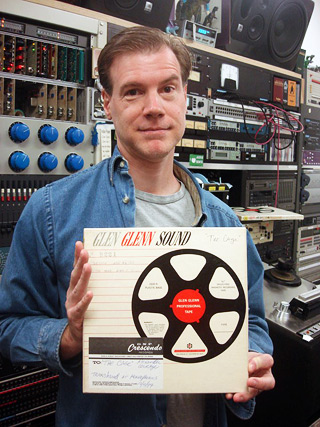 Jeff Bond: I write liner notes for several different soundtrack labels including regular work for La-La Land Records. Michael Gerhard, who runs La-La Land with Matt Verboys, is very generous in giving me a heads up on projects he’s working on and he’s also well aware that I’m a huge Jerry Goldsmith fan, so he alerted me about the Blue Max release several months ago. Julie Kirgo had already written some excellent liner notes for the previous release of the score put out by Intrada, and Michael asked me to augment those with track-by-track descriptions of the Blue Max score cues as they play in the movie.
Jeff Bond: I write liner notes for several different soundtrack labels including regular work for La-La Land Records. Michael Gerhard, who runs La-La Land with Matt Verboys, is very generous in giving me a heads up on projects he’s working on and he’s also well aware that I’m a huge Jerry Goldsmith fan, so he alerted me about the Blue Max release several months ago. Julie Kirgo had already written some excellent liner notes for the previous release of the score put out by Intrada, and Michael asked me to augment those with track-by-track descriptions of the Blue Max score cues as they play in the movie.
Coate: A soundtrack album for The Blue Max has been issued numerous times over the years. What is different about this new release from La-La Land Records?
Bond: This is probably the most exhaustive issue and to my ears it is one of the best-sounding. Michael Matessino has done an amazing job in refining the sound of the elements – he is one of the finest in the business at reconstructing classic film scores. Neil S. Bulk also did an amazing job at assembling the score, determining which takes of music were used and where they were used in the actual movie and how all the music was edited together, because sometimes one music cue will consist of two or three separate takes of a performance by the orchestra. This version also includes some versions of specific cues that have not been released before, simply because they were edited together differently in previous releases of the soundtrack.
Coate: Why did La-La-Land choose to issue a soundtrack for The Blue Max?
Bond: This release is designed to tie together with Twilight Time’s Blu-ray release of The Blue Max. One of the key things about that movie for people who followed the career of Jerry Goldsmith is that, a) The Blue Max is one of the greatest film scores he ever wrote and arguably one of the finest film scores ever written, and b) a lot of the brilliant music Goldsmith wrote was never used in the film and is really known from the various soundtrack releases of the score over the years. So the Twilight Time Blu-ray has two isolated scores that show how Goldsmith originally intended the music to play in the movie. And the reason there are two isolated scores is there is at least one cue where Goldsmith completed more than one version in an attempt to please the director, so you can really follow his intention for the score through the isolated tracks. The La-La Land release presents all the various versions of these cues as well as edits of them that have appeared on various albums over the years, so it is really the most complete version of the score ever put out.
Coate: What is the value of an isolated score on a DVD or Blu-ray?
Bond: As far as isolated scores go, sometimes that's the only way to listen to the complete score (although at this point most of the major film scores that have been written have been released on CD or on iTunes). I think isolated scores are best for people who are interested in looking at how the music score works in the film, and it's particularly interesting in cases like The Blue Max where the score the composer originally wrote was not used the way he intended in the film.
Coate: What are some of the highlight pieces of music from The Blue Max?
Bond: The score has a wonderful, soaring main theme – in fact, the movie’s director, John Guillermin, liked the romanticism of that piece so much that he really wanted the whole score to sound like that, and that’s the reason Goldsmith got into trouble during his work on the rest of the score, because a lot of the music is incredibly brutal, nasty-sounding war music, and Goldsmith was trying to get an actual idea across in the score, which was the contrast between the bloodless beauty of the war in the air and the ugly, muddy war on the ground. So there are gorgeous, exciting cues to do with flying in the score – the main title, “First Blood,” “First Victory” and “The Bridge,” and cues like “The Attack” and “Retreat” that are crushing, magnificently ugly evocations of war.
Coate: Where does The Blue Max rank among Goldsmith’s body of work?
Bond: You could argue that it’s his first truly “great” score although he had certainly done others prior to that that are highly praised. There’s an epic scale to The Blue Max that wasn’t quite present in his earlier works, even The Sand Pebbles, which he did around the same time.
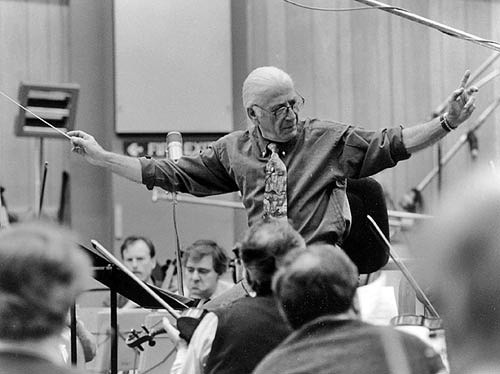
Coate: Why is Jerry Goldsmith so celebrated as a composer?
Bond: He was a chameleon who could write music in an incredible range of styles, so that you could sometimes hear four scores he’d done in the same year and not recognize they were by the same composer. He was daring and put effects into his scores no one had tried before so they often had a unique, sometimes shocking sound, but he also put great feeling into his work and wrote a lot of music that is rousing and beautiful, so his music holds together outside his films for which they were written and they tell their own emotional story, so they’re very satisfying to listen to.
Coate: What is your goal in writing liner notes?
Bond: I try to talk about the effect of music, what the composer was trying to achieve, and I often try to find some underlying meaning in the work, which is particularly enjoyable in regard to Goldsmith’s work because he always seemed to add an extra level of thought to his scores – even though he often said he worked purely on instinct.
Coate: What are some of the challenges in writing liner notes?
Bond: Not being boring! I don’t always succeed at that – music is really impossible to describe, and I am not a composer and don’t write for people who are experts in music; I try to get musical ideas across to the casual reader/listener.
Coate: How do you convince the movie music fan who already owns a previously-issued soundtrack of The Blue Max to buy this latest release from La-La Land?
Bond: I think on the basis of the sound quality alone I would recommend this – I own all the previous releases of the score and this is the one I enjoy listening to most.
Coate: In the last decade or two there has been a surge in “expanded” or “complete score” CD soundtrack releases. To what do you attribute the appeal of such a product?
Bond: The best of these movie scores are fully-composed works, and you get a much better impression of what the composer was trying to accomplish and the whole “world” of the score when you hear all the music. And for every cue that you or I might dismiss, that one little bit of music might be someone’s favorite moment in the score.
Coate: What is the legacy of Jerry Goldsmith’s contribution to The Blue Max?
Bond: It’s one of the greatest war movie scores ever written, certainly one of the most wonderful evocations of flight ever written, and it’s a seminal work by one of the finest composers ever to work in film.
-----
SOURCES / REFERENCES:
The information contained in this article was referenced from regional newspaper promotion and various issues of Boxoffice, Variety and Widescreen Review.
IMAGES:
The Blue Max © 1966 Twentieth Century-Fox Film Corporation.
SPECIAL THANKS:
Jerry Alexander, Jeff Bond, Sheldon Hall, Kim Holston, Bill Huelbig, Stan Malone, Robert Morrow, Jim Perry, Joel Weide, and all of the librarians who helped with the research for this project.
- Michael Coate
